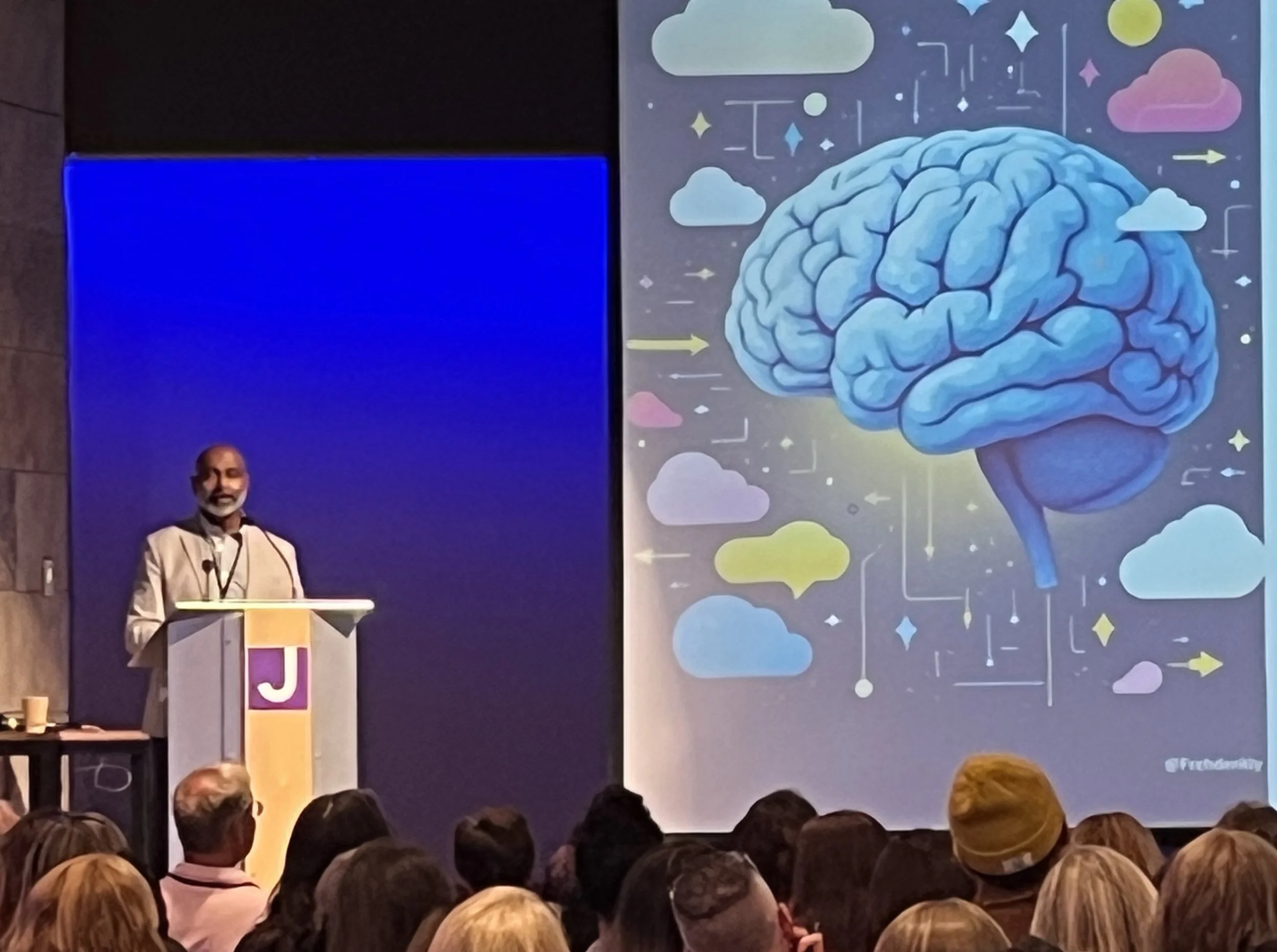Post # 7: 8 Practical Takeaways from the 2025 ATNS Conference to Heal Neuroplastic Symptoms
6 minute read
Boardmember Dr. Howard Schubiner and ATNS president Dr. David Clarke making breakfast fun.
The Association for the Treatment of Neuroplastic Symptoms (ATNS) encompasses about 1000 practitioners and members of the general public from practically every continent. A “tribe” of 350 people (80 more than last year) buzzed with excitement at the 2 ½ day annual ATNS conference last month in beautiful Boulder, Colorado in the southwestern United States. I encountered many physicians with a focused Mind-Body practice like myself, plus others who integrate neuroplastic concepts into their traditional practice (neurosurgeons, anesthesiologists, physical medicine & rehab doctors, primary care doctors, and naturopathic physicians to name a few). Innumerable psychotherapists, physical therapists, chiropractors, audiologists, and health coaches also attended, plus an abundance of podcasters (like Raelan Agle and The Mind Body Couple Tanner Murtagh and Anne Hampson). A sprinkling of recovering or recovered members of the general public joined to improve their understanding of the mind-body model. I revisited with many people I met the previous year and made dozens of new connections.
It was hard to find a person without their hand up when Dr. David Clarke, ATNS president, author of They Can't Find Anything Wrong!: 7 Keys to Understanding, Treating, and Healing Stress Illness, and The Story Behind the Symptoms podcaster, asked how many people in the room have had their own neuroplastic symptoms. The majority of those people, including myself, recovered from significant disability; not by medication or surgery, but by personal transformation.
We’ve all woken up after taking the “red pill.”
As Dr. Matt McClanahan, osteopathic physician and founder of The Center for Insight Medicine in Chattanooga, Tennessee said, we’ve all woken up after taking the “red pill,” referring to 90’s movie icon, The Matrix. ATNS exists not only for neuroplastic education of mind-body practitioners and the public, but for larger social change. The paradigm shift starts with questioning what doesn’t make sense with our current biomedical model. We are closer and closer to the tipping point. Dr. Clarke highlighted new neuroplastic healing books to be published in the coming year and courses eligible for health professional continuing education (a marker of medical respectability).
8 conference takeaways for neuroplastic healing:
1: Improve social connections
Lisa Baranik, PhD, Associate Dean for Research and Associate Professor of Management at University of Albany School of Business in New York presented research showing the link between social exclusion and pain. Improving one or more of the five categories of belonging and connection (friendships, family, intimate relationships, work/civic groups, and community) can improve one’s overall experience of pain.
When I initially developed repetitive motion arm pain in 2014, I was working long hours without much social connection outside of patient care. Over the ensuing 9 years of chronic pain, I intuitively understood that I needed community. I organized fun events with coworkers and a small social group of female doctors. In 2022, after I left work due to disability, I joined a hiking group and took an acting class around the time I learned about the neuroplastic paradigm and began to heal.
Worldwide, the isolation and fear inherent during the Covid pandemic contributed greatly to the overall prevalence of neuroplastic symptoms, especially long-Covid. Because so many activities continue in isolation, including remote work and individualized entertainment platforms, connecting to a larger community is needed more than ever.
2. When symptoms are severe, soothe your nervous system.
Dr. Yonit Arthur, Doctor of Audiology, and The Steady Coach podcaster specializes in chronic dizziness, vertigo, and imbalance. Her recommendations can be generalized to all neuroplastic symptoms, however. She analogized the stress bucket that overflows and causes bodily symptoms. Dr. Arthur stated that when symptoms are severe, the nervous system needs calm before attempting brain retraining techniques. Take a hot bath or lie down in a dark room. Edit your negative self-talk to allow for self-compassion. Relate to your fear. Allow it. Experience it. Don’t try to dampen it, eradicate it, or pretend it isn’t there. This will only increase danger signals.
3. Ground yourself in external and internal safety signals.
Jennifer Franklin, PhD, gastropsychologist from North Carolina, advised setting external safety signals by becoming aware of your present surroundings. Tap into your senses to consider what you see, hear, taste, smell, or feel. Mags Clark-Smith, an Irish pain relief movement specialist, discussed setting internal safety signals. Notice where your body is in space and ground your feet on the floor. Drop into your body by doing a breathing or tapping exercise.
4. Listen to your body. Don’t abuse it or interrogate it.
Kardin Rabin, a nervous system medicine practitioner, cofounder of Somia International, and coauthor of The Secret Language of the Body: Regulate Your Nervous System, Heal Your Body, Free Your Mind, from Massachusetts, plus Alexander Rosan, a massage therapist and bodyworker from Portland talked about practical somatics. Somatics is not a technique; it’s a context of bodily self-awareness involving relationships and experience. Rabin and Rosan explain that the body is not to be used, but rather enriched or explored. When we’re cut off from the body, it’s like living without color in black and white. Mind-body work doesn’t help if the nervous system isn’t relaxed. So close your eyes and listen to your body. Don’t interrogate it. Hold space without agenda; just observe. Allow your consciousness to put a stethoscope on the rest of the brain. Pendulate back to your window of tolerance or safety often. Imagine a child on a playground, coming back to dad for safety before meeting new kids on the swing set.
5. Build a new conversation with pain and neuroplastic symptoms.
Vanessa Blackstone, MSW, ACSW, citizen of the Eastern Band of Cherokee Indians, Executive Director of the Pain Psychology Center in Beverly Hills, CA, and Co-Author of the Pain Reprocessing Therapy Workbook recommended the “NABS Framework” for somatic tracking: Notice the symptoms. Acknowledge them, let them be. Befriend the body part or sensation. Shift from urgency to choice, from danger to safety. It’s not about outsmarting pain. It’s about building a new fearless conversation with pain and changing who is in the driver seat.
6. Don’t push through pain, but don’t avoid triggers either.
Athletic trainer and physical therapist Leonida Tansinsin, MPT from Washington reminded us that symptom flareups are not a sign of tissue damage; instead, they are an alarm bell of an overprotective nervous system. Just like a parent may hold a child’s hand to check for monsters under the bed or in the closet, gradual exposure to dangerously perceived activities is necessary. Another analogy is dipping into a cold pool or hot tub before taking the plunge. Move your body with curiosity and be in the moment. Avoid urgency or pressure. Take deep breaths. Be light, loose, and easy. Don’t brace the body part, which adds to pain prediction.
7. When symptoms persist, examine emotional underpinnings.
Psychologists Mark Lumley, PhD from Wayne State University in Detroit, Michigan and Shoshana Krohner, PhD from Albert Einstein Montefiore Medical Center in New York City demonstrated Emotional Awareness and Expression Therapy (EAET) which facilitates experience and resolution of emotions that underlie neuroplastic symptoms. When emotions associated with unmet core needs (sociability, autonomy, and self-care) are not processed, symptoms develop. EAET has shown positive effects for numerous neuroplastic conditions, including various forms of musculoskeletal chronic pain, fibromyalgia, migraines, IBS, and others. You can make an appointment with me or practice self-directed EAET with Dr. Howard Schubiner’s Unlearn Your Pain workbook in combination with an adapted Embracing Emotions meditation on my website. Be patient. Getting comfortable with experiencing emotions takes practice.
8. Continually recondition your thoughts through awareness.
Les Aria, PhD, pain psychologist and cofounder of Menda Health and The Pointe Malibu Recovery Center recommends an intentional daily practice of safety signals and attention to microhabits. Start with breathwork to provide instant volume control of the emotional system. Continually recondition your thoughts through awareness. When symptoms are triggered, Aria recommends a “3N” somatic tracking framework to build safety. Focus on your breathing or a part of the body that is neutral or positive. Start slowly within your window of tolerance. Notice: what part of your body correlates to a thought or emotion? Name: identify the emotion. Nurture: do tapping or breath work and say, “I’m here for you.”
The ATNS conference ended with volunteers from the audience voicing a brief wish for the neuroplastic community over the coming year. Hopes included further research, collaboration, and improved integration into the current traditional biomedical model. And the cherry on top: Dr. Schubiner and friend leading the audience in Zumba dancing to Stevie Wonder’s “I wish,” reminding us, “let’s live now.”
After a great conference, Rachel Hollander hiking near Chautauqua Park, Boulder, Colorado.













